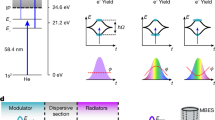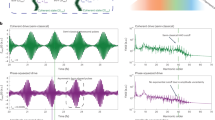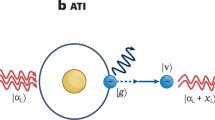Abstract
Attosecond spectroscopy comprises several techniques to probe matter using electrons and photons. One frontier of attosecond methods is to reveal complex phenomena arising from quantum-mechanical correlations in the matter system, in the photon fields and among them. Recent theories have laid the groundwork for understanding how quantum-optical properties affect high-field photonics, such as strong-field ionization and acceleration of electrons in quantum-optical fields, and how entanglement between the field modes arises during the interaction. Here we demonstrate a new experimental approach that transduces some properties of a quantum-optical state through a strong-field nonlinearity. We perturb high-harmonic emission from a semiconductor with a bright squeezed vacuum field, resulting in the emission of sidebands of the high harmonics with super-Poissonian statistics, indicating that the emitted photons are bunched. Our results suggest that perturbing strong-field dynamics with quantum-optical states is a viable way to coherently control the generation of these states at short wavelengths, such as extreme ultraviolet or soft X-rays. Quantum correlations will be instrumental to advance attosecond spectroscopy and imaging beyond the classical limits.
This is a preview of subscription content, access via your institution
Access options
Access Nature and 54 other Nature Portfolio journals
Get Nature+, our best-value online-access subscription
$32.99 / 30 days
cancel any time
Subscribe to this journal
Receive 12 print issues and online access
$259.00 per year
only $21.58 per issue
Buy this article
- Purchase on SpringerLink
- Instant access to full article PDF
Prices may be subject to local taxes which are calculated during checkout




Similar content being viewed by others
Data availability
Data available on request from the authors. Correspondence and requests for materials should be addressed to the corresponding author.
References
Degen, C. L., Reinhard, F. & Cappellaro, P. Quantum sensing. Rev. Mod. Phys. 89, 035002 (2017).
Mukamel, S. et al. Roadmap on quantum light spectroscopy. J. Phys. B 53, 072002 (2020).
Kira, M. et al. Quantum spectroscopy with Schrödinger-cat states. Nat. Phys. 7, 799–804 (2011).
Chrapkiewicz, R. et al. Hologram of a single photon. Nat. Photonics 10, 576–579 (2016).
Adams, B. W. et al. X-ray quantum optics. J. Mod. Opt. 60, 2–21 (2013).
Tamasaku, K. et al. Visualizing the local optical response to extreme-ultraviolet radiation with a resolution of λ/380. Nat. Phys. 7, 705–708 (2011).
Eisenberger, P. & McCall, S. L. X-ray parametric conversion. Phys. Rev. Lett. 26, 684 (1971).
Shwartz, S. et al. X-ray parametric down-conversion in the Langevin regime. Phys. Rev. Lett. 109, 013602 (2012).
Ferray, M. et al. Multiple-harmonic conversion of 1064 nm radiation in rare gases. J. Phys. B 21, L31 (1988).
Krausz, F. & Ivanov, M. Attosecond physics. Rev. Mod. Phys. 81, 163 (2009).
Corkum, P. B. Plasma perspective on strong field multiphoton ionization. Phys. Rev. Lett. 71, 1994 (1993).
Villeneuve, D. M. Attosecond science. Contemp. Phys. 59, 47–61 (2018).
Koll, L.-M. et al. Experimental control of quantum-mechanical entanglement in an attosecond pump–probe experiment. Phys. Rev. Lett. 128, 043201 (2022).
Shiner, A. D. et al. Probing collective multi-electron dynamics in xenon with high-harmonic spectroscopy. Nat. Phys. 7, 464–467 (2011).
Stammer, P. et al. Quantum electrodynamics of intense laser-matter interactions: a tool for quantum state engineering. PRX Quantum 4, 010201 (2023).
Gorlach, A. et al. High-harmonic generation driven by quantum light. Nat. Phys. 19, 1689–1696 (2023).
Gorlach, A. et al. The quantum-optical nature of high harmonic generation. Nat. Commun. 11, 4598 (2020).
Even Tzur, M. et al. Photon-statistics force in ultrafast electron dynamics. Nat. Photonics 17, 501–509 (2023).
Tsatrafyllis, N. et al. High-order harmonics measured by the photon statistics of the infrared driving-field exiting the atomic medium. Nat. Commun. 8, 15170 (2017).
Theidel, D. et al. Evidence of the quantum optical nature of high-harmonic generation. PRX Quantum 5, 040319 (2024).
Lewenstein, M. et al. Generation of optical Schrödinger cat states in intense laser–matter interactions. Nat. Phys. 17, 1104–1108 (2021).
Tzur, M. E. et al. Generation of squeezed high-order harmonics. Phys. Rev. Res. 6, 033079 (2024).
Sloan, J. et al. Entangling extreme ultraviolet photons through strong field pair generation. Preprint at https://arxiv.org/abs/2309.16466 (2023).
Gerry, C. C. & Peter L. K. Introductory Quantum Optics (Cambridge Univ. Press, 2023).
Slusher, R. E. et al. Pulsed squeezed light. Phys. Rev. Lett. 59, 2566 (1987).
Aytür, O. & Kumar, P. Pulsed twin beams of light. Phys. Rev. Lett. 65, 1551 (1990).
Pérez, A. M. et al. Bright squeezed-vacuum source with 1.1 spatial mode. Opt. Lett. 39, 2403–2406 (2014).
Sh. Iskhakov, T. et al. Superbunched bright squeezed vacuum state. Opt. Lett. 37, 1919–1921 (2012).
Cutipa, P. & Chekhova, M. V. Bright squeezed vacuum for two-photon spectroscopy: simultaneously high resolution in time and frequency, space and wavevector. Opt. Lett. 47, 465–468 (2022).
Dudovich, N. et al. Measuring and controlling the birth of attosecond XUV pulses. Nat. Phys. 2, 781–786 (2006).
Vampa, G. et al. Linking high harmonics from gases and solids. Nature 522, 462–464 (2015).
Ghimire, S. et al. Observation of high-order harmonic generation in a bulk crystal. Nat. Phys. 7, 138–141 (2011).
Orenstein, G. et al. Shaping electron-hole trajectories for solid-state high harmonic generation control. Opt. Express 27, 37835–37845 (2019).
Rasputnyi, A. et al. High-harmonic generation by a bright squeezed vacuum. Nat. Phys. 20, 1960–1965 (2024).
Bertrand, J. B. et al. Ultrahigh-order wave mixing in noncollinear high harmonic generation. Phys. Rev. Lett. 106, 023001 (2011).
Purschke, D. N. et al. Microscopic mechanisms of high-order wave mixing in solids. Phys. Rev. A 108, L051103 (2023).
Manceau, M. et al. Indefinite-mean Pareto photon distribution from amplified quantum noise. Phys. Rev. Lett. 123, 123606 (2019).
Lettau, T. et al. Superthermal photon bunching in terms of simple probability distributions. Phys. Rev. A 97, 053835 (2018).
Jahangiri, S. et al. Point processes with Gaussian boson sampling. Phys. Rev. E 101, 022134 (2020).
Allevi, A., Cassina, S. & Bondani, M. Super-thermal light for imaging applications. Quantum Meas. Quantum Metrol. 4, 26–34 (2017).
Vollmer, C. E. et al. Quantum up-conversion of squeezed vacuum states from 1550 to 532 nm. Phys. Rev. Lett. 112, 073602 (2014).
Kizmann, M. et al. Subcycle squeezing of light from a time flow perspective. Nat. Phys. 15, 960–966 (2019).
Riek, C. et al. Subcycle quantum electrodynamics. Nature 541, 376–379 (2017).
Dupont, E. et al. Phase-controlled currents in semiconductors. Phys. Rev. Lett. 74, 3596 (1995).
Sederberg, S. et al. Vectorized optoelectronic control and metrology in a semiconductor. Nat. Photonics 14, 680–685 (2020).
Jana, K. et al. Quantum control of flying doughnut terahertz pulses. Sci. Adv. 10, eadl1803 (2024).
Christ, A. et al. Probing multimode squeezing with correlation functions. New J. Phys. 13, 033027 (2011).
Acknowledgements
We acknowledge D. Crane and R. Kroeker for providing continuing technical support; B. Sussman, G. Thekkadath, F. Bouchard, J. Lundeen, D. Reis and P. Corkum for useful discussions; J. Upham for lending specialized equipment. G.V. and S.A.J. acknowledge financial support from the Joint Center for Extreme Photonics. G.V. acknowledges support from NSERC Discovery grant RGPIN-2021-04286. D.P. acknowledges support from the NSERC Postdoctoral fellowship programme. S.L. and G.V. acknowledge support from the NRC Quantum Sensing programme, project QSP-103.
Author information
Authors and Affiliations
Contributions
G.V. conceived the experiment. S.L., S.A.J., D.N.P. and T.J.H. performed the experiment with help from N.B. and D.V. N.B. and T.B. developed the theoretical model. A.N. maintained the infrastructure. T.B. and G.V. supervised the project. G.V. wrote the manuscript with help from all co-authors.
Corresponding author
Ethics declarations
Competing interests
The authors declare no competing interests.
Peer review
Peer review information
Nature Photonics thanks Olga Kocharovskaya, Michael Krüger and the other, anonymous, reviewer(s) for their contribution to the peer review of this work.
Additional information
Publisher’s note Springer Nature remains neutral with regard to jurisdictional claims in published maps and institutional affiliations.
Extended data
Extended Data Fig. 1 Direct up-conversion of BSV.
(a) When the BSV pulse energy is 30 nJ, the 3rd and 5th harmonics of the BSV frequency are measurable. Note that the spectral width is much narrower than the sidebands because the BSV bandwidth is limited to 50 nm, corresponding to a coherence time of 75 fs. (b) Without the bandpass filter on the BSV beam, up to the 7th harmonic is measured with a BSV energy of 37 nJ (the 3rd harmonic is not measured in this case as it is outside the detected range of the spectrometer). Single-shot measurements of this spectrum allow to retrieve the g(2)(0) = 7.9 and 4.9 for the 5th and 7th harmonics of the BSV beam, respectively.
Extended Data Fig. 2 Scaling of sidebands and harmonics with BSV power.
The sidebands power scales linearly with the BSV pulse energy, in agreement with a wave-mixing interpretation of in-situ high-harmonic control, suggesting a one-photon mixing process in the BSV beam. The colored areas denote the uncertainty of one standard deviation of the set of single-shot spectra.
Extended Data Fig. 3 Sketch of experimental layout.
‘PBS’: Polarizing beam splitter, a combination of half-wave plate and thin-film polarizer; ‘Spectrometer’: Princeton Instruments IsoPlane 320, equipped with PI-MAX4 intensified camera; ‘OAP’: Off-Axis Parabola, f = 25 mm (Thorlabs MPD119-M01); ‘AGS’: 400 μm-thick, θ = 39 deg, φ = 45 deg, AR coated 1–2.6 μm on the front surface, AR 2.6–11 μm on the back surface. ‘Imaging system’ includes an InGaAs camera (Xenics Bobcat+ 320). All mirrors after the ZnO crystal are Al-coated vacuum ultraviolet mirrors (Acton coating #1900). Monitoring photodiodes for the mid-infrared and BSV beams are not shown.
Extended Data Fig. 4 Modal analysis of the BSV beam.
(a) Spatial mode of the BSV averaged over 100 shots. (b) First principal component from the most prominent eigenvector of the covariance matrix of flattened single-shot images, displaying nearly identical structure to the average spatial mode. (c) Average spectrum before (orange) and after (blue) spectral filtering and representative single-shot spectra from the two distinct clusters (black lines). (d) Monte Carlo sampling of two uncorrelated distributions, one with thermal (exponential) statistics, representing the non-degenerate mode (dashed black line in panel c), and one with BSV statistics, representing the degenerate mode (dotted black line in panel c). The orange and blue curves represent the case where the two modes have equal intensity and where the non-degenerate mode has 10 percent of the intensity of the degenerate mode, respectively. These situations correspond approximately to the filtered and unfiltered spectra in (c).
Rights and permissions
About this article
Cite this article
Lemieux, S., Jalil, S.A., Purschke, D.N. et al. Photon bunching in high-harmonic emission controlled by quantum light. Nat. Photon. 19, 767–771 (2025). https://doi.org/10.1038/s41566-025-01673-6
Received:
Accepted:
Published:
Issue date:
DOI: https://doi.org/10.1038/s41566-025-01673-6
This article is cited by
-
Attosecond quantum uncertainty dynamics and ultrafast squeezed light for quantum communication
Light: Science & Applications (2025)
-
High-harmonic generation meets quantum optics
Nature Photonics (2025)



